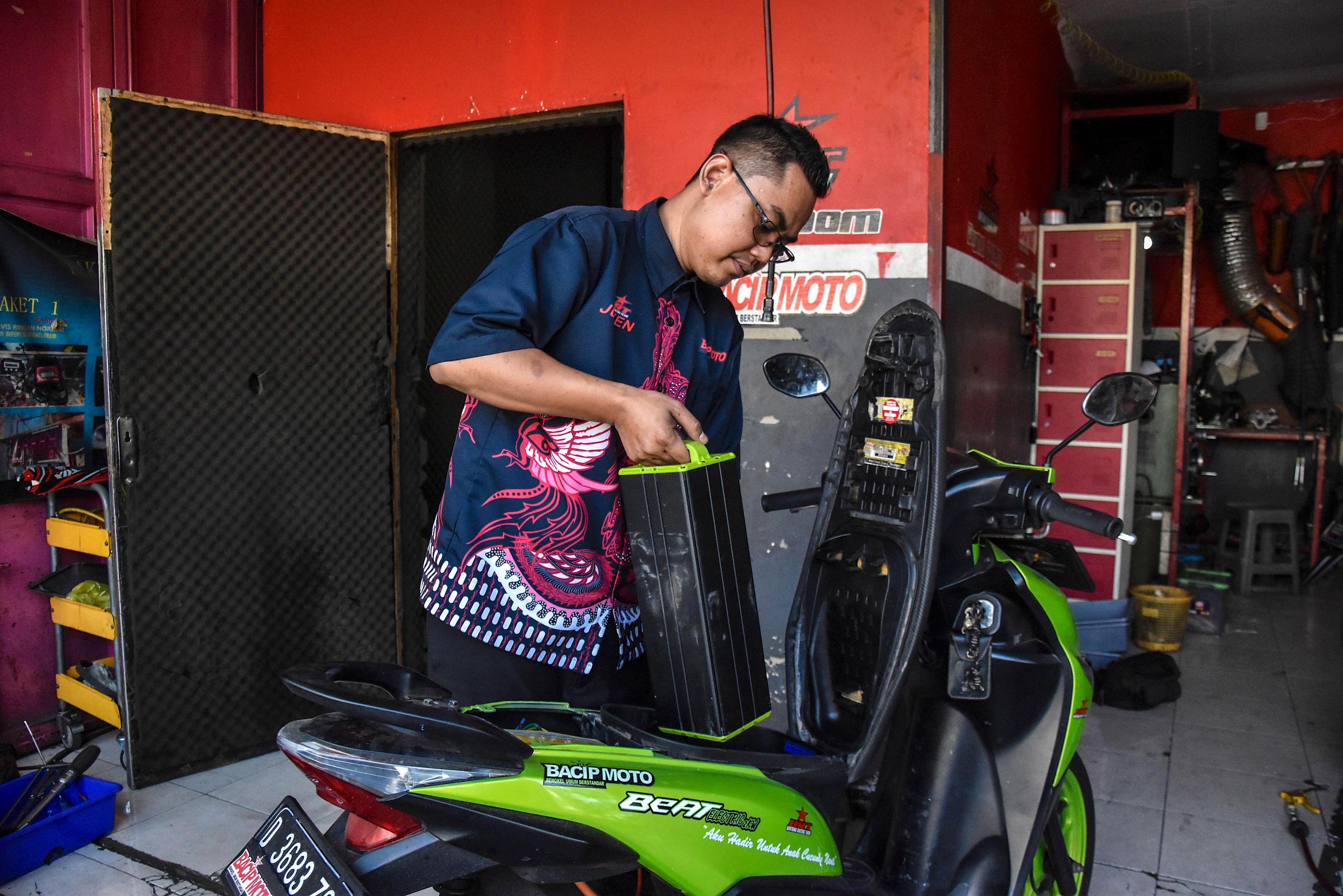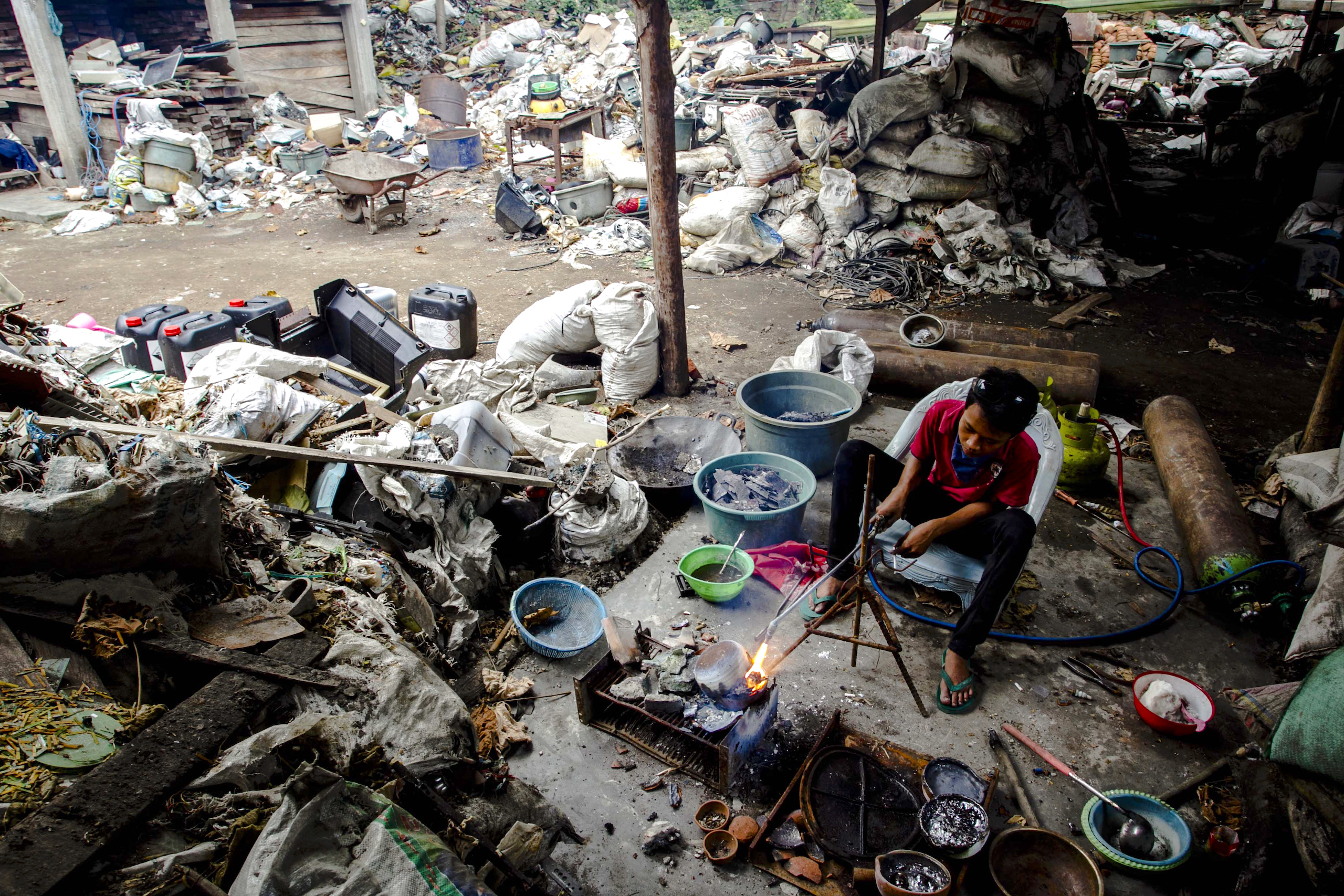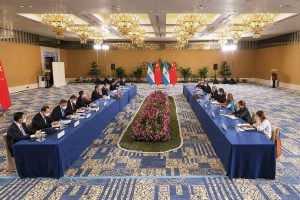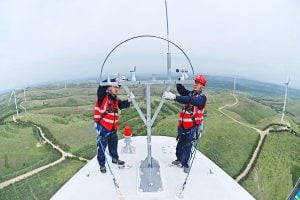Komang Ratih recently bought her 10-year-old son an electric moped so he could ride to school independently. They live on the Indonesian island of Bali, where electric vehicles are becoming increasingly popular. Smaller and lighter than motorbikes, electric mopeds (e-mopeds) are considered the safer of the two, as well as more convenient, because they do not require registration to drive. With a starting price of around IDR 6 million (USD 365), they are also more affordable. As of December 2023, 4,500 electric vehicles (EVs) were registered in Bali – 400 of which were four-wheelers – among a population of approximately 4.3 million. Yet, the rise of EVs here highlights a critical challenge: managing the growing pile of used batteries.
Indonesia, with its population of 275 million, had 125 million motorcycles in circulation as of 2022. That year, the country set itself ambitious targets of 2.1 million electric two-wheelers (E2Ws) by 2025 and 13 million by 2030. However, by January 2024 the number of registered E2Ws stood at just 75,000. Although numbers in Bali rose following the introduction of subsidies in March 2023, the slow uptake underlines the effort required to meet these targets.
Current recycling infrastructure: established but insufficient
Unlike most EVs on the market, e-mopeds use sealed lead acid (SLA) batteries rather than pricier lithium-based options. This is what makes e-mopeds at least 50% cheaper than lithium-powered alternatives. While SLA batteries are cheaper, they typically last between just one and three years.
SLA batteries have long been a critical element of combustion engine vehicles, and their component parts (plastic, lead, sulphuric acid) are mostly recyclable. Once discarded, they are often sold on as scrap and broken down for recycling. The plastic is chopped into smaller pieces and melted into pellets for reuse, while the lead is smelted into bars in a furnace and the acid is either reused in new batteries or neutralised.
“For SLA batteries, the recycling ecosystem in Indonesia is pretty much established,” says Indra Perdana, who leads a battery waste research team at Gadjah Mada University in Java. “Even Astra [a major vehicle distributor] already has a dedicated unit to recycle lead acid batteries.”
Although this infrastructure is already in place, safety waste disposal measures have failed to keep up. Faris Adnan Padhilah, a researcher at the Institute for Essential Services Reform in Jakarta, says that SLA batteries are not being carefully disposed of, leading to health problems in communities. In Bogor, West Java, mismanagement of SLA waste has caused lead poisoning that left multiple children with physical or mental needs, he notes.
“It is possible that used SLA batteries go back to their factories for recycling, but the current recycling ecosystem is still not immune to dangers,” Padhilah says. Leaving them outside or exposed to sunlight is dangerous, and any long-term public health impacts can take as long as ten years to fully materialise, he adds.
Decentralisation versus centralisation: what is Indonesia’s battery recycling capacity?
The Indonesian government regulates the handling of hazardous waste, requiring collectors and waste managers to obtain a permit from their district governor. However, the regulations published by the Ministry of Environment and Forestry in 2021 lack important details, making no provision on how different types of toxic waste should be treated.
The implementation of these regulations is also “not monitored”, claims Catur Yudha Hariani, who heads the Environmental Education Centre (PPLH) Bali, an NGO. “Sometimes, waste pickers will disassemble batteries and sell the parts separately. That’s very dangerous, because they are exposed to hazardous chemicals that can ruin their health,” she says. This lack of oversight means children as young as six have been known to collect and dismantle e-waste.
To move towards greater EV adoption, authorities will need to provide clear guidelines on how to manage waste, Perdana suggests. “It requires entities to process battery-related waste, but I don’t see any follow-up regulations on this,” he says. Follow-up regulations designed at ministerial and district levels, he adds, could provide detail on how to implement the guidelines on the ground.
Hariani is researching Bali’s preparedness for the incoming battery waste from its growing EV sector. Several district governments have started initiatives to build recycling drop-boxes, but are struggling with low budgets from the central government. “For instance, the budget for Gianyar [a regency of Bali] to manage hazardous waste is only IDR 3 million [USD 182] per year, which is just enough to monitor the existing waste management system, not to improve it,” she says.
Moreover, SLA battery processing is concentrated in a few cities in Java, such as Surabaya and Cirebon. With no e-waste recycling industry of its own, Bali’s e-waste must be transported to these areas. Paola Cannucciari, a programme manager for waste services provider ecoBali, says the cost of transportation is typically “too high” for waste managers operating in areas without recycling infrastructure. “So, it’s really important for Indonesia to find a way to decentralise its recycling industry,” she explains.
Scaling up for lithium
Perdana believes the dominance of SLA batteries in the Indonesian EV market is temporary. He says lithium-based batteries, particularly lithium-iron-phosphate (LFP) and nickel-manganese-cobalt (NMC) types, are more likely to become the preferred choice for manufacturers in the long run due to their affordability, longer lifespan and suitability for various types of vehicles.
NMC and LFP batteries are both recyclable, but require different technologies, meaning they need to be collected separately. Currently, Indonesia is still developing comprehensive EV-specific recycling regulations.
Padhilah notes that the Indonesian government has not restricted the sale of E2Ws with SLA batteries, unlike other countries that have chosen to limit EV subsidies to lithium-powered options. This lack of restriction means SLA batteries may persist for longer in the market, particularly for low-cost, short-distance vehicles.
The government needs to immediately issue further regulationsFaris Adnan Padhilah, researcher at the Institute for Essential Services Reform
While the government has focused on expanding recycling capacity and monitoring illegal waste collection, Perdana worries these efforts might only suffice for SLA batteries. An influx of discarded lithium-based batteries could overwhelm existing systems.
Research conducted by the Institute for Essential Services Reform in 2023 indicates the country currently only has small-scale recycling operations for lithium batteries. According to Padilah, these operations are constrained by outdated regulations that classify battery waste simply as waste, rather than as a resource. This classification complicates transportation and increases costs, particularly in an archipelagic country like Indonesia.
“The policies are outdated,” Padhilah says. “If we look at the presidential decree [on EV acceleration] released in 2019, that’s five years ago.” He points out the decree focuses mainly on manufacturing and charging, lacking a comprehensive policy framework for developing robust recycling capabilities. “The government needs to immediately issue further regulations,” he adds.
Indonesia’s vast nickel supply makes NMC batteries the logical national alternative to SLA. The government has announced its intention to develop the downstream nickel industry, encouraging EV companies like Tesla to choose Indonesia for its new nickel-based battery plants. The Indonesian state’s oil and gas company Pertamina and the Chinese battery manufacturer Tianneng have both expressed interest in building EV lithium battery recycling facilities in Indonesia. At the time of writing, however, specific plans had not yet materialised. Meanwhile, 75% of the EVs sold in Indonesia in 2023 used LFP batteries, despite being less profitable to recycle.
Padhilah thinks Indonesia should consider importing dead batteries to increase its volume of recyclable materials, which he argues would turn waste into a valuable resource. “Indonesia doesn’t have a significant lithium reserve, so by importing [and recycling] dead batteries, we can obtain some of this lithium,” he says. “Other countries in Southeast Asia have contemplated doing their own urban mining, but they also still lag behind when it comes to building recycling centres. Indonesia should have taken a head start.”
Whichever battery type ultimately dominates, Perdana says more detailed recycling regulation is needed, “down to how each type of battery should be sorted and collected”.
Padhilah agrees that a shift towards lithium batteries, which offer a longer lifespan and incorporate more advanced technology, is necessary. He believes that, to achieve its ambitious EV targets and effectively manage the resultant waste, Indonesia needs to rapidly develop a recycling infrastructure capable of handling the diverse range of battery types in its electric future. Padhilah says replicating the SLA recycling system (of enabling customers to exchange old batteries for discounts on new ones) could help manage lithium battery waste more effectively.
“There is not enough discussion at a policy level about building a recycling ecosystem,” Padhilah concludes. “From my conversation with government officials, recycling isn’t a priority … we still have a long way to go.”










